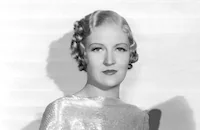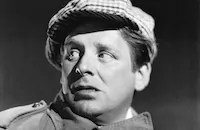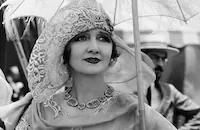Skyscraper Souls

Brief Synopsis
Cast & Crew
Edgar Selwyn
Warren William
Maureen O'sullivan
Gregory Ratoff
Anita Page
Verree Teasdale
Film Details
Technical Specs

Synopsis
The Dwight Building, an elegant, one hundred story architectural wonder in New York City, is owned by banker David Dwight, who values the edifice more than anything. When the Board of Directors of Seacoast Bank, of which David is president, tells him that bank examiners may question the legality of the huge outstanding loan which he made to himself for the building, David determines to save his building at any cost. Even Sarah Dennis, David's mistress of many years and closest advisor, does not realize the extent to which David will go to keep the Building. Her love and loyalty to David has blinded her to the fact that his in-name-only wife Ella is merely an excuse not to marry Sarah, and that he ruthlessly goes after everything he wants. He tries to effect a merger with banker Hamilton, but is unsuccessful because Hamilton wants to remove David as president of the new bank. David then decides to pursue his old friend Charlie Norton of the Manhattan Bank. During a party in Norton's honor, David lures Sarah's secretary, Lynn Harding, up to his penthouse apartment. Lynn, an innocent girl who is devoted to Sarah, thinks that David wants her to deliver a report. When she arrives at the penthouse, she reluctantly takes a glass of champagne from David and soon becomes drunk. She then falls asleep on David's bed, forgetting that Tom Shepherd, a young bank teller with whom she is in love, is waiting for her downstairs. When Lynn awakens at three in the morning, David propositions her. She refuses him, then he takes her down to the lobby of the building, where Tom, who is hiding, sees them and assumes the worst. The next day, Tom angrily confronts Lynn and they break up when she says she doesn't want to marry anyone as jealous as he. When Lynn tearfully tells Sarah what has happened, Sarah takes Tom to lunch and explains, then encourages him to reconcile with Lynn. When he says that Lynn insists that they need more money to get married, she suggests that he take his savings and invest in Seacoast stock. Although Tom keeps his "insider" information secret, word spreads about the Seacoast-Manhatten merger and the stock soars. Soon people are investing everything they have, buying the stock on margin, certain that their dreams will come true. Meanwhile, Hamilton approaches David with a plan to make him and David rich by inflating the Seacoast stock, then selling short and ruining the rest of the stockholders. David eagerly accepts the plan, and some time later the stock rises to $350 a share, then plummets. Many people are wiped out when the stock drops, including Tom and Norton. When Norton confronts David, he is unremorseful and revels in the fact that he now owns the Dwight building outright. Almost everyone is against David, except Lynn, who decides to go with David to Europe when Tom's jealous outbursts continue. Sarah confronts David just before he is to leave, however, and begs him not to ruin Lynn's life the way he ruined hers. When he starts to leave, Sarah shoots him. Pretending not to be seriously injured, David tells his butler to get a doctor and wipes Sarah's fingerprints from the gun as he explains that he had an accident. He tells Sarah that he will always care for her, then dies. Realizing what she has done, Sarah then goes to the roof of the building and jumps off. Some months later, Ella sells the building and Lynn and Tom decide to start a new life together, realizing that money is not as important as they thought.

Director
Edgar Selwyn
Cast

Warren William

Maureen O'sullivan

Gregory Ratoff

Anita Page

Verree Teasdale

Norman Foster

George Barbier

Jean Hersholt

Wallace Ford

Hedda Hopper
Helen Coburn
John Marston
Purnell B. Pratt
Arnold Lucy

Edward Brophy

Billy Gilbert

Tom Kennedy
Crew

Videos
Movie Clip



Film Details
Technical Specs

Articles
Skyscraper Souls
The Empire State Building had been completed in 1931, and at 102 stories was the tallest building in the world at that time. Although its funding came through the kind of stock speculation and manipulation that caused the Stock Market Crash in 1929, its completion was seen to be a symbol of America's greatness. Baldwin's novel and the film capitalize on the Empire State sensation as its intertwining story lines (a plot device that had been so successful in MGM's other 1932 film Grand Hotel) take place in and around a new 72 story building in New York City.
Skyscraper Souls has plenty of what the public wanted to see in 1932, and what would eventually be banned by the Production Code only two years later: sex, sex, and more sex, 1930's style. Warren William stars as the skyscraper owner who uses everyone to achieve his ends. He has been having an affair with his assistant (played by Verree Teasdale) whom he continues to string along by telling her that his wife (played by future gossip columnist Hedda Hopper) won't give him a divorce. That's because he hasn't asked her for one.
Maureen O'Sullivan, newly signed at MGM and having just completed filming her most famous film, Tarzan the Ape Man (1932), played the young secretary he tries to seduce while Norman Foster plays the boyfriend who wants her to stop working and marry him. O'Sullivan seems to have spent much of 1932 changing into skimpy garments or appearing nude on-screen (thanks to a body double in Tarzan). Here she is seen in her lingerie in her boss's apartment.
Like Grand Hotel it contains another important element common in films of the early 1930s: the suicide of a character who has been swindled and bankrupted by greedy stock traders. Recent headlines had been full of similar stories since 1929. Hollywood itself was on the verge of bankruptcy as the effects of the Crash began to be felt by 1931 as moviegoers couldn't afford the price of a ticket. As it would again in the 1950s, film studios made racier films to bring the audiences back. Unlike the 1950s, sexy films like Skyscraper Souls helped fuel the backlash that led to the adoption of the Production Code in 1934 and the taming of films.
Skyscraper Souls was well received, as noted in the August 5, 1932 New York Times review by Mordaunt Hall, " Skyscraper Souls affords a rich measure of entertainment, and in it Mr. William has a further opportunity to give an excellent characterization. With the introduction of various persons who work in the imposing Dwight Building, the pride of David Dwight (Mr. William), the story is replete with suspense and vitality. There are the financial fights, the snaring of a good-hearted soul named Norton, who enters into a big business deal with Dwight while they are in a Turkish bath, and the greedy speculators who are caught in a shrewdly manipulated stock debacle. In spite of the fact that some of the characters and their doings recall certain happenings in The Mouthpiece [another 1932 film starring Warren William], Edgar Selwyn, the director, has succeeded in sustaining the interest in this tale. Norman Foster, who acts the part of Tom Shepherd, a most persistent pursuer of Lynn Harding, impersonated by Maureen O'Sullivan, gives a gratifying portrayal. His colliding with other persons and piles of boxes may occur a little too frequently, but as these clashes were rewarded by hearty laughter from yesterday afternoon's audience, it must be presumed that Mr. Selwyn was not wrong in introducing such rowdy bits of comedy...Besides Mr. William's clever acting, there are highly commendable portrayals by Miss O'Sullivan, Mr. Foster, Verree Teasdale, Gregory Ratoff, Anita Page, Jean Hersholt, Hedda Hopper and George Barbier."
Director: Edgar Selwyn
Screenplay: C. Gardner Sullivan, Elmer Harris, Faith Baldwin (novel)
Cinematography: William Daniels
Film Editing: Tom Held
Art Direction: Cedric Gibbons
Music: Rudolf Bial, Emil Frey
Cast: Warren William (David Dwight), Maureen O'Sullivan (Lynn Harding), Gregory Ratoff (Mr. Vinmont), Anita Page (Jenny LeGrande), Verree Teasdale (Sarah Dennis), Norman Foster (Tom Shepherd).
BW-99m.
by Lorraine LoBianco
SOURCES:
All Movie Guide
www.moviediva.com
www.cinescene.com
A Banker's Ambition by Mordaunt Hall, New York Times , August 5, 1932

Skyscraper Souls
Quotes
Oh golly, I can't believe it. Am I dreaming?- Jake Sorenson
Well, where do you want to be pinched?- Jenny LeGrande
Trivia
Notes
The working title of the film was Skyscraper. According to news items in Hollywood Reporter, Faith Baldwin's novel was purchased in July 1931 by M-G-M, at which time John Lynch was signed to adapt it for the screen. In August 1931 it was announced that Edith Fitzgerald was to adapt the novel, and in September 1931 Una Merkel, Madge Evans and Robert Young were announced as the stars, with Harry Beaumont set to direct. Though Fitzgerald's name was mentioned as the scenarist until October 1931, she did not receive onscreen credit, nor was she mentioned in reviews. When the picture began production in early June 1932, new writers, a new director and a new cast had been assigned to the film.














